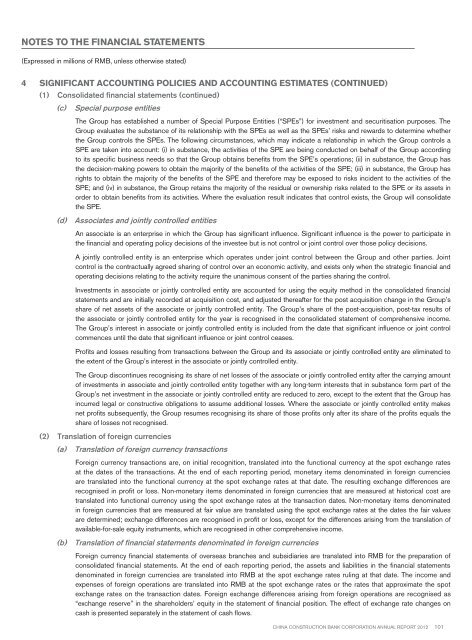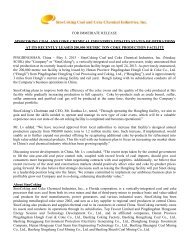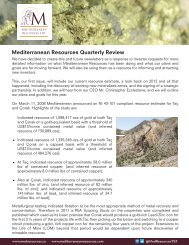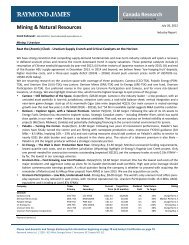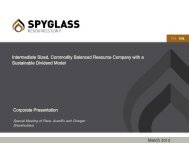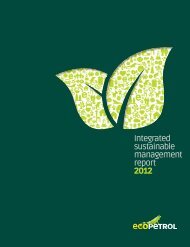Annual Report 2012
Annual Report 2012
Annual Report 2012
- No tags were found...
Create successful ePaper yourself
Turn your PDF publications into a flip-book with our unique Google optimized e-Paper software.
Notes to the financial statements(Expressed in millions of RMB, unless otherwise stated)4 Significant accounting policies and accounting estimates (continued)(1) Consolidated financial statements (continued)(c)Special purpose entitiesThe Group has established a number of Special Purpose Entities (“SPEs”) for investment and securitisation purposes. TheGroup evaluates the substance of its relationship with the SPEs as well as the SPEs’ risks and rewards to determine whetherthe Group controls the SPEs. The following circumstances, which may indicate a relationship in which the Group controls aSPE are taken into account: (i) in substance, the activities of the SPE are being conducted on behalf of the Group accordingto its specific business needs so that the Group obtains benefits from the SPE’s operations; (ii) in substance, the Group hasthe decision-making powers to obtain the majority of the benefits of the activities of the SPE; (iii) in substance, the Group hasrights to obtain the majority of the benefits of the SPE and therefore may be exposed to risks incident to the activities of theSPE; and (iv) in substance, the Group retains the majority of the residual or ownership risks related to the SPE or its assets inorder to obtain benefits from its activities. Where the evaluation result indicates that control exists, the Group will consolidatethe SPE.(d) Associates and jointly controlled entitiesAn associate is an enterprise in which the Group has significant influence. Significant influence is the power to participate inthe financial and operating policy decisions of the investee but is not control or joint control over those policy decisions.A jointly controlled entity is an enterprise which operates under joint control between the Group and other parties. Jointcontrol is the contractually agreed sharing of control over an economic activity, and exists only when the strategic financial andoperating decisions relating to the activity require the unanimous consent of the parties sharing the control.Investments in associate or jointly controlled entity are accounted for using the equity method in the consolidated financialstatements and are initially recorded at acquisition cost, and adjusted thereafter for the post acquisition change in the Group’sshare of net assets of the associate or jointly controlled entity. The Group’s share of the post-acquisition, post-tax results ofthe associate or jointly controlled entity for the year is recognised in the consolidated statement of comprehensive income.The Group’s interest in associate or jointly controlled entity is included from the date that significant influence or joint controlcommences until the date that significant influence or joint control ceases.Profits and losses resulting from transactions between the Group and its associate or jointly controlled entity are eliminated tothe extent of the Group’s interest in the associate or jointly controlled entity.The Group discontinues recognising its share of net losses of the associate or jointly controlled entity after the carrying amountof investments in associate and jointly controlled entity together with any long-term interests that in substance form part of theGroup’s net investment in the associate or jointly controlled entity are reduced to zero, except to the extent that the Group hasincurred legal or constructive obligations to assume additional losses. Where the associate or jointly controlled entity makesnet profits subsequently, the Group resumes recognising its share of those profits only after its share of the profits equals theshare of losses not recognised.(2) Translation of foreign currencies(a) Translation of foreign currency transactionsForeign currency transactions are, on initial recognition, translated into the functional currency at the spot exchange ratesat the dates of the transactions. At the end of each reporting period, monetary items denominated in foreign currenciesare translated into the functional currency at the spot exchange rates at that date. The resulting exchange differences arerecognised in profit or loss. Non-monetary items denominated in foreign currencies that are measured at historical cost aretranslated into functional currency using the spot exchange rates at the transaction dates. Non-monetary items denominatedin foreign currencies that are measured at fair value are translated using the spot exchange rates at the dates the fair valuesare determined; exchange differences are recognised in profit or loss, except for the differences arising from the translation ofavailable-for-sale equity instruments, which are recognised in other comprehensive income.(b) Translation of financial statements denominated in foreign currenciesForeign currency financial statements of overseas branches and subsidiaries are translated into RMB for the preparation ofconsolidated financial statements. At the end of each reporting period, the assets and liabilities in the financial statementsdenominated in foreign currencies are translated into RMB at the spot exchange rates ruling at that date. The income andexpenses of foreign operations are translated into RMB at the spot exchange rates or the rates that approximate the spotexchange rates on the transaction dates. Foreign exchange differences arising from foreign operations are recognised as“exchange reserve” in the shareholders’ equity in the statement of financial position. The effect of exchange rate changes oncash is presented separately in the statement of cash flows.China Construction Bank Corporation annual report <strong>2012</strong>101


